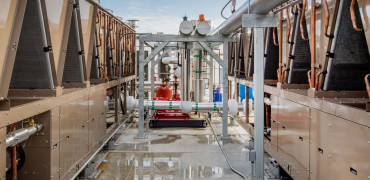Recent updates to Part L of the Building Regulation are rightly gaining a lot of attention, in part because of the new tougher drive on carbon reduction in the built environment.
The targets coming into force in June 2022 push permitted CO2 emissions from new non-dwellings down to around 27% less than current standards.
And this is merely a staging post on the way to 2025 when reduction targets be tighter.
But the focus of the latest Regulation updates is not only on new buildings or the design stage.
Government has learned the lesson that what looks good on paper is not always what’s delivered, and it wants to close the performance gap.
As a result, operational energy use is also something that building owners and managers need to focus on.
For building owners, the clear message is that all buildings must be fit for the future
Energy use forecasting
Part L (2021) requires that new buildings over 1000m2 must also provide an energy use forecast at handover. This must be in kWh per year and broken down by fuel type.
And in existing buildings, if fixed building services are updated, the legislation requires information on energy performance of the new system.
The updated Building Regulations reflect the fact that a low-carbon and energy-efficient built environment will play a key role in getting the UK to its goal of net zero carbon by 2050.
For commercial building owners and managers, the clear message is that all buildings must be fit for the future.
Good practice
Good maintenance practice is vital to ensure that buildings maintain operational efficiency.
This is particularly true for building services, where we generally find a significant level of energy use in cooling and heating systems. Keeping equipment such as chillers performing at their optimal level means that regular service and maintenance must be top of the agenda.
Meeting the challenge of making buildings fit for the future demands integrated thinking all the way from design to installation and maintenance. At Mitsubishi Electric Service & Maintenance, we have been focusing on long-term efficiency with many of our clients.
One of the ways we are doing this is to use the latest technology to offer remote monitoring, backed up with 24/7 engineer response.
Remote monitoring allows our engineers to observe the performance of chillers, for example. Any changes in performance patterns create an immediate alert. Adjustments can be made remotely, or a maintenance expert can be sent to site.
Minimising downtime
This is an approach that not only ensures energy efficient operation, but also minimises downtime for crucial heating and cooling systems – while extending the life of valuable building services assets.
HVAC kit today is built to last but needs regular service and maintenance to achieve a long and effective lifetime.
Left to its own devices, equipment won’t necessarily develop faults, but performance will degrade. As that happens, it will not only use more energy but also reach its end-of-life sooner.
Therefore, regular servicing must go beyond the minimum yearly tick-box exercise. Mitsubishi Electric service packages include complete bi-annual check-ups, including checking on refrigerant levels with diagnostic software and full reports on performance. Our expert team can even strip down and reassemble equipment, which can be necessary in locations where equipment is difficult to access.
There can be no doubt that in our low-carbon, energy-efficient future we must put the emphasis firmly on maintenance for efficiency and long-life of building services.
There is no other way to guarantee long-term optimal performance. Buildings fit for the future are what your service & maintenance teams should deliver.
Graham Martin is Business Development Manager




